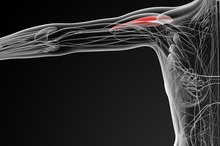Tennis Ball Massage for Piriformis Syndrome
Piriformis syndrome can be defined as pain in the butt 2. Fortunately if caught in time, treatment is as simple as breaking out a tennis ball. No, you won't be playing any sets right away, but you will feel relief quickly.
Piriformis Syndrome
The piriformis muscle runs from the sacrum (at the base of the spine) to the top of the femur 2. It is flat, triangular, and runs roughly parallel to the floor. Piriformis syndrome is a repetitive stress injury where the muscle—which assists in hip rotation and balance—is pushed beyond its limits without enough recovery time, or not stretched before exercise such as running 2.
In piriformis syndrome, the muscle responds to overuse by tightening 2. This puts pressure on the tendons which hold the muscle in place. It can also cause irritation of the sciatic nerve, and this can be very painful.
- The piriformis muscle runs from the sacrum (at the base of the spine) to the top of the femur 2.
- In piriformis syndrome, the muscle responds to overuse by tightening 2.
Those At Risk
Knee Pain From Kicking a Ball
Learn More
Piriformis syndrome is common among runners, or any athlete who uses their legs for long periods of time 2. Since the injury is primarily caused by overuse, it is more common in runners than in other groups of people.
The Tennis Ball Fix
The easiest treatment for this syndrome is to apply direct pressure to the piriformis—this releases tension in the muscle 2. If the case is mild, you can often take care of it by sitting on a tennis ball. This gives firm, but not unyielding pressure on the muscle.
Technique
Pain Above the Knee Cap With Running
Learn More
The best results come if you perform this technique several times each day. It takes some practice, and it may cause some immediate discomfort to the area. Let’s assume the piriformis on the right side is causing pain 2. If your pain is on the left side, simply change sides.
Find a comfortable chair with a firm seat. Place a tennis ball on the spot with the most pain and sit. Do not put all of your weight on the ball, just to the point where you feel some pain. Hold for 20 seconds, then move the ball around to another pain spot. Repeat. Move the tennis ball across the length of the piriformis, putting direct pressure on as much of it as possible 2. Do not make it so painful that you have to stop. After working the entire muscle, cross your legs. Place the tennis ball under and just inside the outer hip bone. Work again with the tennis ball across the area. If it hurts, you're probably doing it right.
- The best results come if you perform this technique several times each day.
- Place a tennis ball on the spot with the most pain and sit.
It Still Hurts, Now What?
If you still hurt after a couple of treatments, it's time to call a licensed massage therapist. Be sure to inform your LMT that you tried the tennis ball technique, but you are still in pain. The LMT will perform a massage on the gluteal region to break up toxins built up in the muscle and release the stressed piriformis 2. On severe cases, several treatments may be necessary. For some, however, one or two treatments followed by the tennis ball technique may do the trick.
- If you still hurt after a couple of treatments, it's time to call a licensed massage therapist.
- Be sure to inform your LMT that you tried the tennis ball technique, but you are still in pain.
Related Articles
References
- Trail Guide To The Body, 3rd Edition; Arthur Biel; 2005
- Piriformis Syndrome
- Theory and Practice of Therapeutic Massage, 4th Edition; Mark F. Beck; 2005
- Cass SP. Piriformis syndrome: a cause of nondiscogenic sciatica. Curr Sports Med Rep. 2015;14(1):41-4. doi:10.1249/JSR.0000000000000110
- Jankovic D, Peng P, Van Zundert A. Brief review: piriformis syndrome: etiology, diagnosis, and management. Can J Anaesth. 2013;60(10):1003-12. doi:10.1007/s12630-013-0009-5
- Bardowski EA, Byrd JWT. Piriformis injection: an ultrasound-guided technique. Arthrosc Tech. 2019;8(12):e1457–e1461. Published 2019 Nov 13. doi:10.1016/j.eats.2019.07.033
- Jankovic D, Peng P, van Zundert A. Brief review: piriformis syndrome: etiology, diagnosis, and management. Can J Anaesth. 2013;60(10):1003-12.
Writer Bio
Stephen Venneman is a 10-year veteran TV news producer and licensed massage therapist. He holds a Bachelor's degree in journalism from the University of Oregon, a Masters in health and wellness psychology from the University of the Rockies, a diploma in massage therapy from Apollo College, and certification in neck and cervical spine pain relief as well as cupping therapy.








